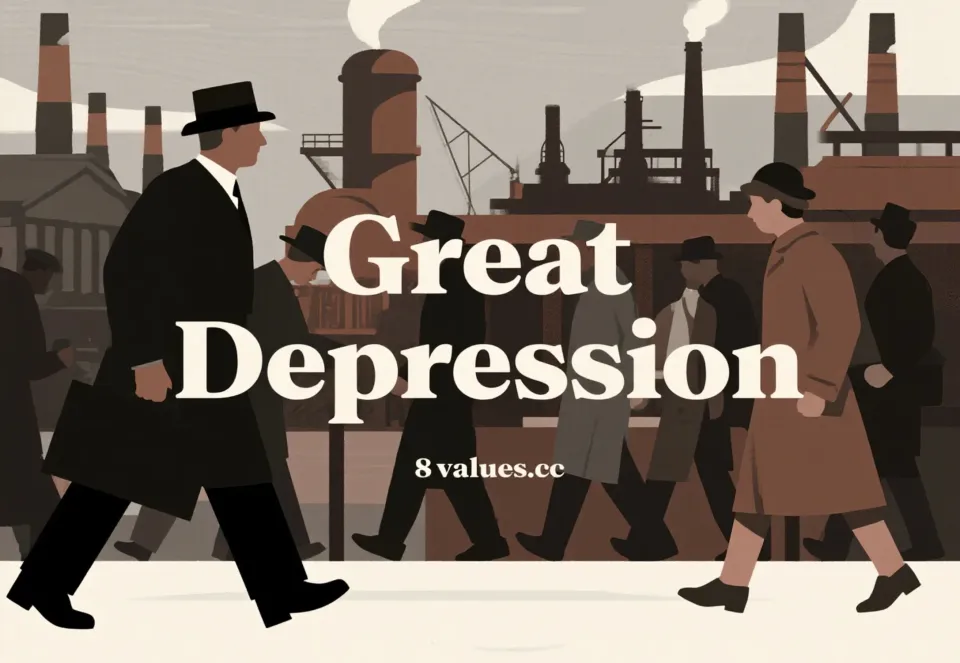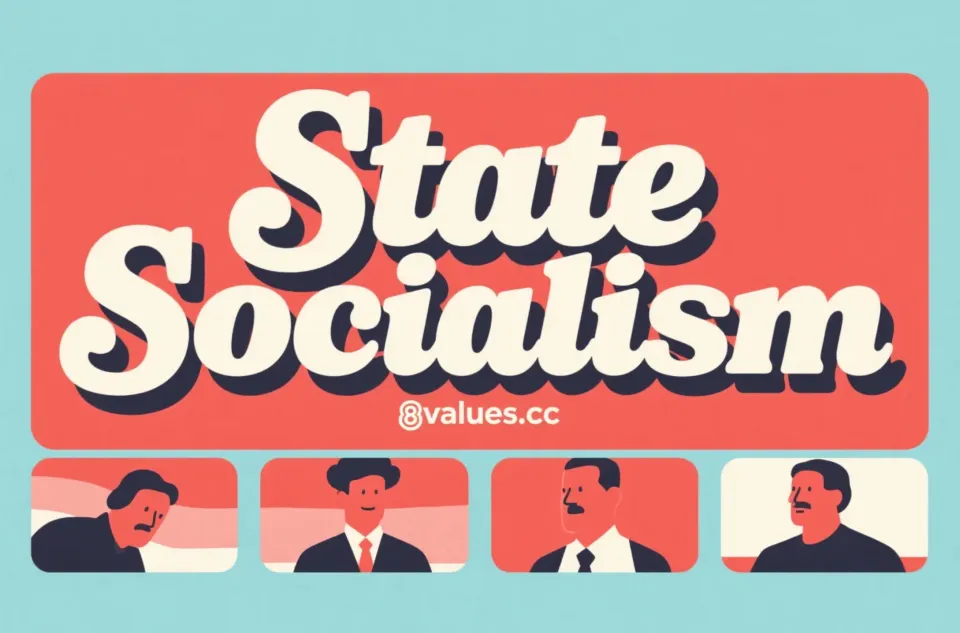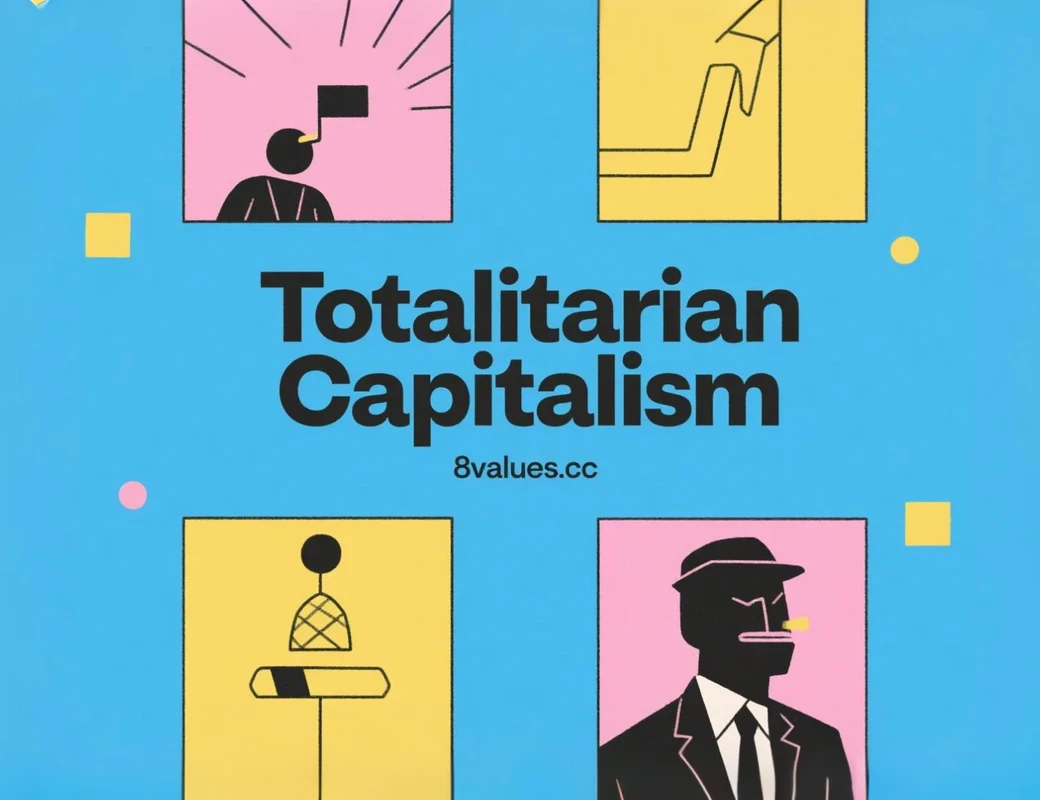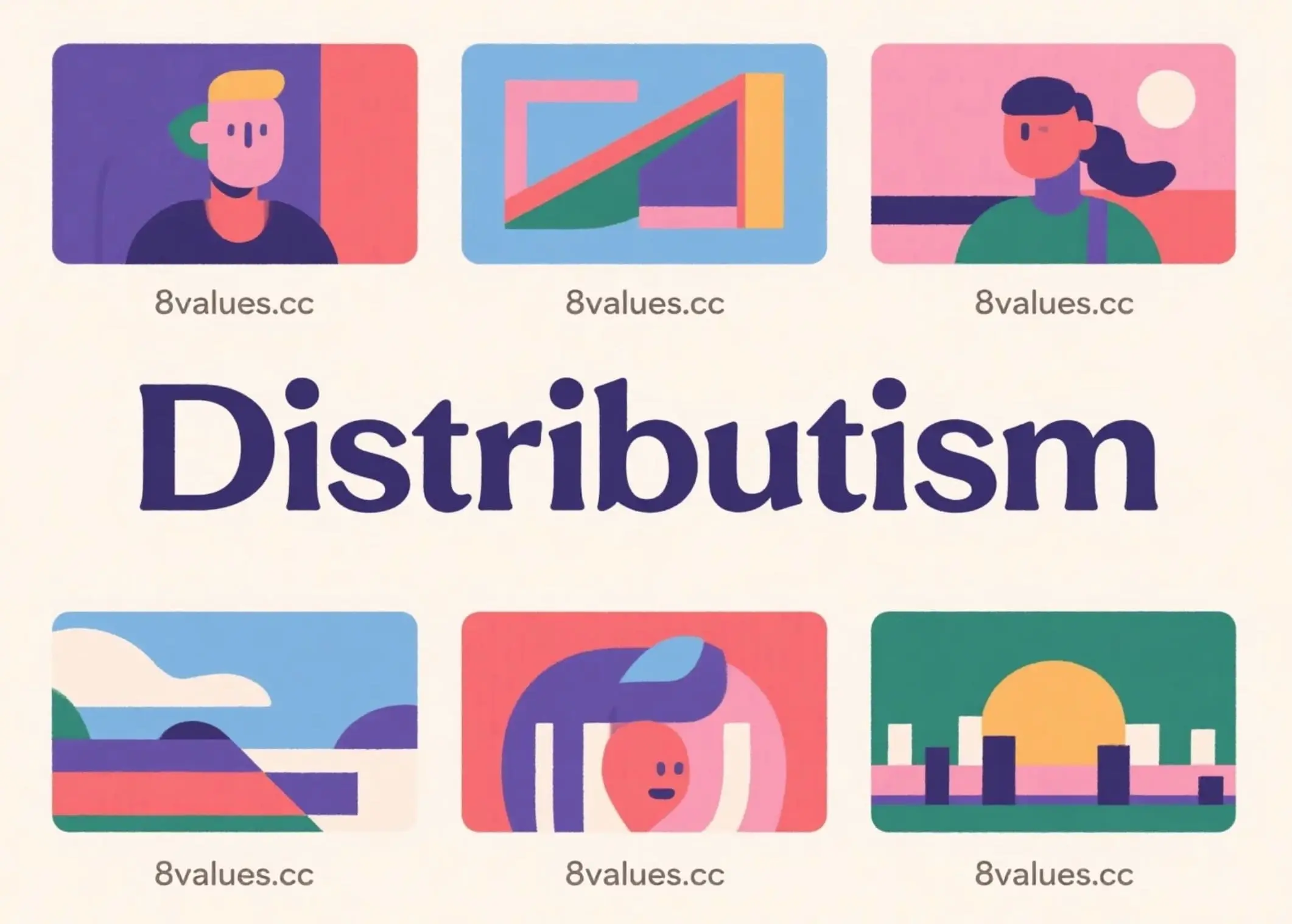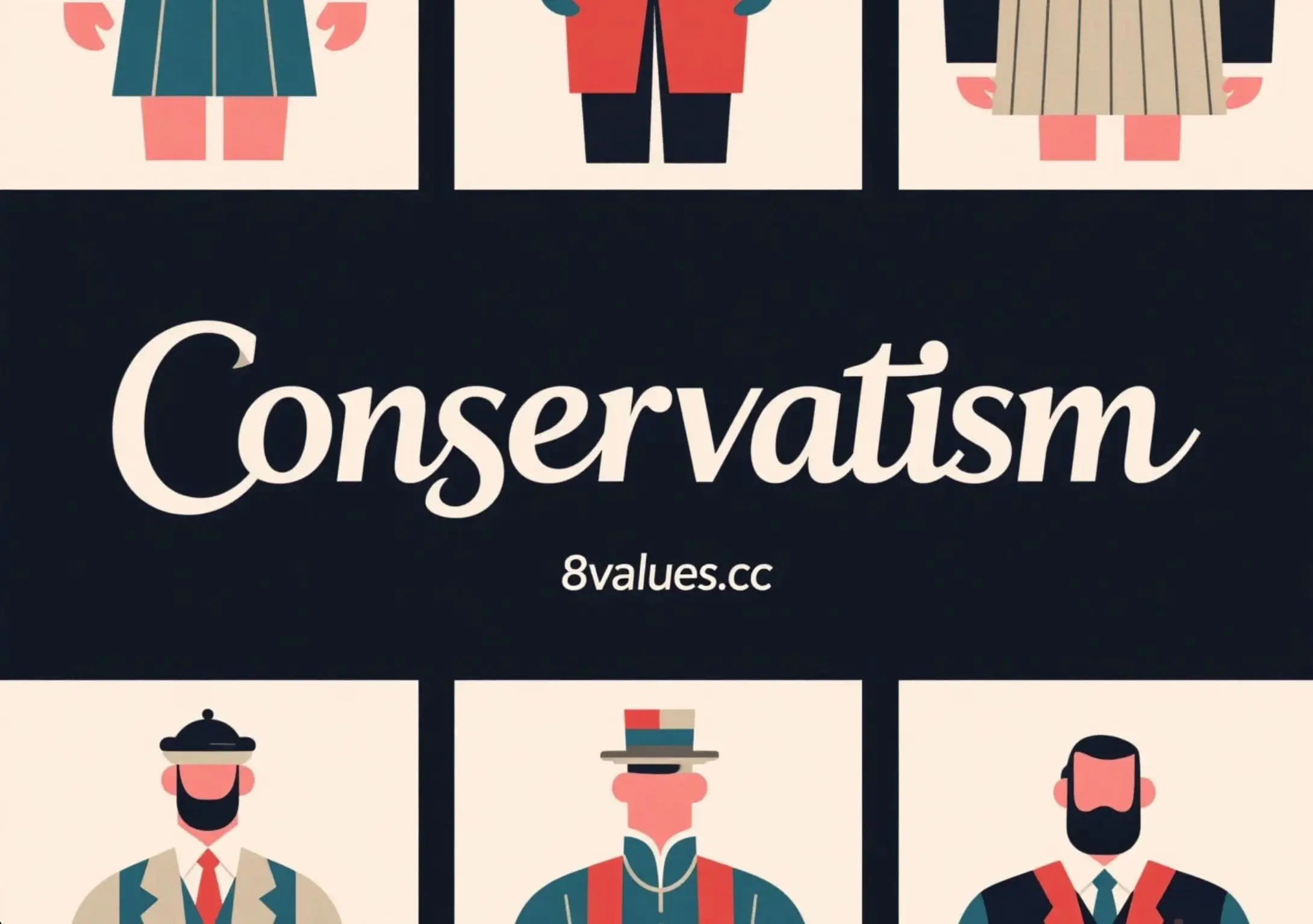A deep interpretation of the Great Depression: History, Causes and Revelations
This article deeply explores the outbreak of the Great Depression, the deep causes, socio-economic impacts, national response strategies and long-term historical heritage of the 20th century. By reviewing this critical historical period, we aim to understand the importance of economic resilience and change and to inspire reflection on personal and social values, as discussed through the 8 values test of political values.
The Great Depression is the worst and longest global economic recession of the 20th century. It is often believed to have begun in 1929 and lasted until the outbreak of World War II in 1939. The crisis first broke out in the United States and then quickly spread around the world, causing massive unemployment, poverty, a sharp decline in industrial production and international trade, and a wide range of bank and business banking. Understanding the history of The Great Depression not only helps us learn valuable economic lessons, but also prompts us to think about how individuals and collectives choose their response paths when society faces huge challenges, as revealed by the 8values political values test .
The Great Depression: Wall Street Crash of 1929
The Great Depression was usually marked by the Wall Street stock market crash on October 24, 1929 , and this day was called "Black Thursday." At the time, panicked investors sold a record 12.9 million shares, and the Dow Jones Industrial Average opened down 11%. Despite a brief stabilization of the day, the following Black Monday (October 28) and Black Tuesday (October 29) witnessed a more drastic decline, with the Dow falling more than 20% in two days, with a new record of 16.4 million shares in a single day.
The stock market crash wiped out tens of billions of dollars in just a few weeks, and many investors lost all their money and the stock could not even be sold at any price. By 1930, the value of stocks had fallen by 90%. Although the stock market crash is a trigger for the recession, most historians and economists believe that it is not the only cause of the Great Depression, but a symptom of deeper economic problems.
Deep reasons: Structural weaknesses of the economy
The precise cause of The Great Depression remains controversial, but it is generally believed to be the result of a combination of factors. These factors include both the structural weaknesses in the United States and the complex international economic environment after World War I.
The hidden worries under the illusion of prosperity: wealth inequality and excessive credit
In the Roaring Twenties before the stock market crash, the U.S. economy experienced significant growth, with the country's total wealth more than doubled between 1920 and 1929. However, this prosperity is not based on solid foundations.
- Uneven distribution of wealth : The fruits of economic prosperity have not benefited everyone. Wealth is highly concentrated, with the top 0.1% of the wealthy making up nearly a quarter of their pre-tax income, while about 60% of households earn less than the lowest level of maintaining a decent living ($2,000). This gap between the rich and the poor has sown fragile seeds for the economy.
- Over-credit and speculative fanaticism : The popularity of new technologies (such as cars, radios, washing machines) and mass production have driven the rise of consumerism, however, most consumption is achieved through credit and installment payments. By 1929, 75% of furniture and 60% of cars were purchased on credit. The surge in the stock market has further fueled speculative fanaticism, with people borrowing to buy stocks (margin trading, margin buying), even up to 90% of the stock's value, causing the stock price to deviate from the fundamentals and reach an unreasonable level.
- The fragility of the banking system : The U.S. banking system at that time lacked effective regulation, and many small independent banks loaned large amounts of assets to stock speculators. Once the stock market collapses, these loans cannot be recovered, resulting in a large number of banks going bankrupt.
Policy mistakes: gold standard, trade protectionism and monetary tightening
A series of policy mistakes further exacerbated and extended the severity of The Great Depression.
- Smoot-Hawley Tariff Act : In 1930, the Hoover administration passed the Smoot-Hawley Tariff Act, imposing high tariffs on thousands of imported goods, aiming to protect the U.S. economy from foreign competition. However, the move triggered retaliatory tariffs from other countries, causing a sharp drop in international trade volume by more than 50%, and the collapse of the global trade system, which in turn exacerbated the economic crisis.
- The constraints of the Gold Standard : After World War I, countries worked hard to rebuild the gold standard, but this fixed exchange rate system limited the flexibility of countries in dealing with economic shocks. When the economic crisis comes, countries that stick to the gold standard cannot stimulate exports and economic recovery through currency depreciation, which instead leads to deflation and gold outflows. Economies that abandoned the Gold Standard in the early days (such as the United Kingdom, Scandinavian countries, Japan) recovered faster.
- Federal Reserve System’s mistake : The Federal Reserve System failed to effectively perform its “lender of last resort” duties in the early stages of the crisis. During the bank panic, the Fed did not expand its money supply or inject liquidity into the banking system, but instead raised interest rates, making credit more difficult to obtain, resulting in a sharp contraction of the money supply by 35%. This "Great Contraction" is considered a key factor in the evolution of a normal recession into the Great Depression. Former Fed Chairman Ben Bernanke publicly admitted in 2002: "You are right about the Great Depression (Milton Friedman and Anna Schwartz). We did it. We are deeply sorry. But thanks to you, we won't make it again."
Social and economic impact: touching every aspect of daily life
The Great Depression had a profound and extensive impact on the American and global society, touching everyone's daily life.
Massive unemployment and poverty
- Unemployment tide : By 1933, the U.S. unemployment rate soared from 3.2% in 1929 to an all-time high of 24.9% (or 25%). This means that about 15 million Americans (more than 20% of the U.S. population at that time) lost their jobs. In some cities, the unemployment rate is even as high as 50% to 80%.
- Income drops sharply : Even those who were lucky enough to keep their jobs, wage income fell by 42.5% between 1929 and 1933. The average American household's income fell by 40%.
- "Hoovervilles" : Millions of Americans are homeless, building simple shanty towns with cardboard boxes, abandoned cars and broken wood in urban vacant lands. They are ironically called "Hoovervilles" to express their dissatisfaction with the policies of then-President Herbert Hoover.
- Hunger and malnutrition : Due to the plummeting prices and sharp decline in income, many families are unable to eat. It is not uncommon to fight for food residues in the garbage dump. Soup kitchens and food stamps are the only way for many to get free meals and daily necessities. In mining counties such as West Virginia, the proportion of malnutrition children is as high as 90%.
- Family rupture : The sudden arrival of poverty has caused serious psychological trauma. Many families disintegrate under pressure, divorce and informal separation rates rise, and young people drop out of school and go out to wander. Marriage and birth rates have dropped sharply because people are worried about not being able to afford families. The suicide rate increased significantly by 22.8%.
Disasters of agriculture and industry
- Agricultural crisis : Agricultural product prices plummeted by as much as 60%. Many farmers lost their land and homes as a result. Coupled with years of excessive farming and drought in the Midwest Plains, the ecological disaster known as the Dust Bowl forced hundreds of thousands of farmers to leave their hometowns and migrate westward to places such as California.
- Industrial production stagnated : Industrial production fell by nearly half between 1929 and 1932. Factory closures, mines are abandoned, and the production of durable goods (such as cars and electrical appliances) is seriously affected.
The impact and transformation of values
- Thrift and self-reliance : A generation who experienced the Great Depression knew the importance of resource conservation and thrift. Growing food (such as using Patriot Seeds’ Survival Seed Vault seed library), learning to hunt, fish and gather wild food, and stockpiling essentials (such as the March emergency food supply from My Patriot Supply, with a shelf life of up to 25 years) has become the way for many families.
- Community and Family Links : In difficult times, family and community connections become particularly important. Relatives often live together, neighbors help each other, and even organize "surprise parties" to collect food and money for families in need.
- Changes in Gender Role : Massive unemployment breaks the traditional concept that "husband is the only breadwinner." Married women and mothers entered the paid labor market at a record high, and although they were less unemployed at white-collar jobs, there were widespread calls in society that restricted only one person from their families from working.
- Psychological shocks of social and psychological impact : Long-term unemployment and poverty put huge pressure on people's mental health. Crime rates have risen, including homicide, gambling and suicide.
Government response: Hoover and Roosevelt’s strategy
Faced with an unprecedented economic crisis, the US government's reaction has undergone a transition from "non-interventionism" to large-scale intervention, which has also profoundly influenced the American people's views on the role of the government.
The Hoover Administration's initial attempt
President Herbert Hoover (1929-1933) initially upheld the laissez-faire economic philosophy, believing that the government should not directly interfere in the economy, nor be responsible for creating jobs or providing financial assistance to citizens. He tends to solve problems through voluntarism and local mutual assistance .
- Encourage businesses to maintain wages and employment : Hoover encourages businesses not to lay off or cut wages to maintain purchasing power, but as the economy deteriorates, businesses have to cut wages and lay off employees.
- Public Works Projects : Hoover has also promoted large-scale public works projects such as the Hoover Dam and the Golden Gate Bridge. He encouraged state and local governments to increase public works spending.
- Smoot-Hawley Tariff Act : As mentioned earlier, this protectionist policy has not only not improved the economy, but has instead exacerbated the collapse of global trade.
- Financial Aid : The Hoover administration set up Reconstruction Finance Corporation (RFC) to provide emergency assistance to banks and financial institutions on the verge of bankruptcy, but its $2 billion loan amount is not enough to save all banks.
- Tax Policy : Hoover had cut taxes in 1929 due to his budget surplus, but by 1931, in order to balance the budget, he had to raise the maximum income tax rate from 25% to 63%. Some viewpoints suggest that the move may worsen the economy further.
Although Hoover implemented several measures during his term, he was widely regarded as the president who failed to successfully deal with the crisis due to his policies failing to effectively curb the economic downturn and was defeated by Franklin D. Roosevelt in the 1932 general election.
Roosevelt's "New Deal"
On March 4, 1933, Franklin D. Roosevelt was in office as president and vowed to take "bold, continuous experiments" to deal with the crisis. His "New Deal" is a series of unprecedented relief, recovery and reform plans that profoundly change the role of the US government.
- Bank Reform : Roosevelt announced the Bank Holiday at the beginning of his tenure, closing all banks, and then passed the Emergency Banking Relief Act and the Glass-Steagall Act to restructure the banking system and establish the Federal Deposit Insurance Corporation (FDIC) to protect depositors’ deposits. These measures effectively restore public confidence in the financial system.
- Employment and Public Works : The New Deal has launched a number of public works projects such as the Civilian Conservation Corps (CCC), the Public Works Administration (PWA) and the Works Progress Administration (WPA), providing jobs to millions of unemployed people. These projects not only create jobs, but also improve national infrastructure.
- Social Security : The Social Security Act was passed in 1935 and established a nationwide pension, unemployment insurance and disability assistance system, providing an important social safety net for the American people.
- Agricultural Adjustment : The Agricultural Adjustment Act was passed, and the government provided subsidies to farmers to encourage them to reduce their output to increase agricultural product prices.
- Monetary policy adjustment : Roosevelt abolished the Gold Standard and banned private hoarding of gold to make monetary policy more flexible in dealing with deflation.
Although the New Deal significantly alleviated people's suffering and stimulated the economy to a certain extent, the economic recovery has not been smooth sailing. Between 1937 and 1938, the U.S. economy experienced a double-dip recession, and unemployment surged again, partly due to the Federal Reserve's tightening of monetary policy and the Roosevelt administration's spending cuts. The economics community still debates about the impact of the New Deal on The Great Depression, with some scholars prolonging the recession, while others laying the foundation for the final recovery.
Global spread and international impact
The Great Depression is by no means unique to the United States, and it spread rapidly around the world, affecting wealthy and poor countries.
- The transmission mechanism of the Gold Standard : The Gold Standard is the main mechanism that causes the global spread of the crisis. The decline in the U.S. economy has led to a decline in trade, capital flows and global business confidence, which has led to economic recessions in other countries.
- Countries responded differently : Different countries have different ways of responding to crises and their severity.
- UK : As the economic recession had already experienced in the late 1920s, Britain was relatively less initially hit by the Great Depression and abandoned the Gold Standard earlier in 1931, it recovered faster.
- Germany : The German economy is highly dependent on US loans, and the crisis caused unemployment to reach 30%, exacerbating political extremism and paving the way for Adolf Hitler and his Nazi Party to take office in 1933.
- Japan : The Great Depression has little impact on Japan. Japan's Finance Minister Takahashi Korekiyo implemented Keynesian economic policies: large-scale fiscal stimulus and currency depreciation doubled Japan's industrial production in the 1930s.
- France : France was affected a little later by the crisis, but it recovered slowly due to its longer adherence to the Gold Standard.
- Latin America and European African colonies : These regions have been hit hard by their dependence on U.S. investment and primary product exports. Commodity prices plummeted and export demand plummeted, resulting in widespread unemployment and poverty.
- Soviet Union : As the only socialist country at that time, the Soviet Union's economy had little connection with the rest of the world, so it was almost unaffected by the Great Depression. Instead, it was favored by some Western intellectuals because of its economic stability.
The discussion of the causes and coping strategies of The Great Depression also deeply reflects the society's understanding and trade-offs about different economic ideologies (as described in the 8values All Results ideologies ).
The End of the Great Depression and Historical Legacy
The true end of The Great Depression is generally considered the outbreak of World War II . The war stimulated factory production, provided a large number of young unemployed men with opportunities to join the army, and also provided factory employment for women, thus completely ending large-scale unemployment. By the end of 1941, defense spending and military mobilization had triggered the largest economic boom in U.S. history, eliminating the last trace of unemployment.
The Great Depression left a profound historical legacy, most notably the dramatic shift in the role of government in the economy .
- Government intervention became the norm : After the Great Depression, the federal government's role in the economy has expanded significantly. The proportion of federal government spending in GDP increased from less than 3% in 1929 to more than 10% in 1939. The idea that governments should act in times of economic crisis, expand liquidity, cut taxes and stimulate aggregate demand is widely accepted.
- Strengthening of financial regulation : To prevent similar banking crises from happening again, the United States has established a stricter financial regulation system, including institutions such as the Federal Deposit Insurance Corporation (FDIC) and the Securities and Exchange Commission (SEC), aiming to protect depositors and investors.
- The rise of Keynesianism : The theory proposed by British economist John Maynard Keynes advocates that governments should stimulate demand through deficit spending in a recession to achieve full employment. Although its policies were not fully adopted by major countries in the 1930s, Keynesianism became the mainstream of Western economic policy after World War II.
- Establishment of the Social Security Network : The establishment of the social security system provides basic economic security for American citizens and mitigates the risk of future economic shocks.
- Lessons from international relations : The Great Depression prompted the United States to participate more in international affairs after World War II to prevent similar economic disasters and world wars from happening again.
Historical experience tells us that the Great Depression is not an inevitable failure of capitalism, but a result of misleading government policies —especially the failure of the Federal Reserve system to prevent the collapse of the money supply. It emphasizes the importance of sound macroeconomic policies in ensuring economic stability.
Wealth and Opportunity: Successful People in Adversity
Although The Great Depression brought great suffering to the vast majority of people, a few people accumulated huge wealth during this period.
- J. Paul Getty : This oil tycoon believes in the business philosophy of "buy when everyone sells, hold when everyone buys." He made huge profits by acquiring a large number of oil company stocks and real estate during the 1929 stock market crash.
- Charles Clinton Spaulding : As head of North Carolina Mutual Life Insurance Company, the largest black company in the United States, Spaulding expands its company into fire insurance, banking and mortgage through its sales and marketing expertise. He was still regarded as the leading black businessman in the United States during the period when African-American unemployment was at its highest.
- Michael Cullen : He innovatively launched the first self-catering supermarket in the United States, King Kullen, to attract budget-conscious consumers with low prices, commodities and ample parking spaces.
- Glenn Miller : The jazz band leader became the king of pop music in the 1930s, earning nearly $20,000 per week.
- Gene Autry : Known as the "Singing Cowboy", Gene Autry ushered in a golden age of career during the Great Depression, starring in more than 40 films and becoming the box office leader in Western films. He later created the television and broadcast empire and purchased the California Angels.
These successful cases show that even in the most difficult economic times, business innovation, prudent investment strategies, and accurate grasp of consumer demand can still create wealth. This reminds us that in any era, the choices and actions of individual values can lead to different results. If you are interested in political values in different socio-economic contexts, you can try 8 values of political values in a test to gain insight into your personal ideology.
Through a comprehensive review of The Great Depression, we can see that the economic crisis is not a purely digital game, it has had a profound impact on society, culture and individual psychology. History does not repeat exactly, but its rhythms are often surprisingly similar. As a proverb says, "Everything that has happened will happen again." Only by a deep understanding of the past can we better prepare for the future and make wise choices when facing uncertainty. Whether it is personal life or national policies, we should focus on long-term planning, risk management and care for the overall well-being of society.
